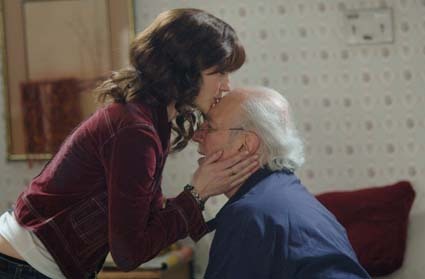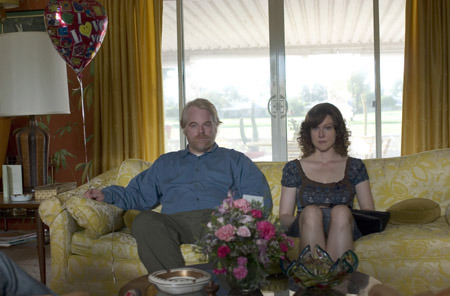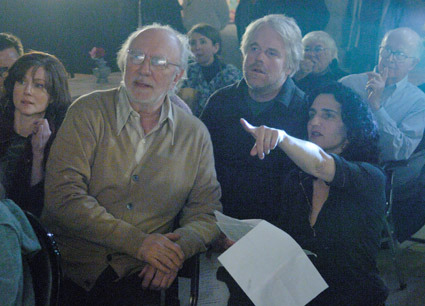The Business of Art: A Conversation with Tamara Jenkins
Tamara Jenkins (far right) On the set of The Savages. Left to right: Laura Linney, Philip Bosco, Philip Seymour Hoffman. (All photos: Andrew Schwartz)
In 1998 screenwriter, director, and NYFA Film Fellow Tamara Jenkins released her debut film Slums of Beverly Hills to widespread acclaim. Jenkins’ film follows a young woman persisting through her teenage years as an anomalous member of the working class in one of the richest zip codes in the country. Since then she abandoned a screenplay about photographer Diane Arbus, took on various odd jobs, and attended the Yaddo residency program where she honed her writing for a second feature film, The Savages, which premiered at the Sundance Film Festival in January. A lacerating, hard-edged comedy, The Savages follows the re-unification of Philip Seymour Hoffman and Laura Linney, estranged siblings whose chaotic lives are further undone by their unresolved reconciliation with a dementia-scarred 75 year-old father who is entering a nursing home. Just prior to the release of The Savages in theaters nationally, film critic Patrick Z. McGavin caught up with Jenkins in Chicago.
Patrick Z. McGavin: You were a performance artist before you began making films. How did your work as a performance artist shape your screenwriting and filmmaking?
Tamara Jenkins: Originally I wanted to be an actor, but became very frustrated by the lack of control. It’s a pretty rough trade. It’s sort of frustrating not to be able to author your own fate. When I was in my 20s I got involved with theater companies in Boston that were kind of interesting and experimental. The first piece I ever did was a highly autobiographical thing called Family Album, based on photographs I found in old boxes in my mother’s house. It was a 45-minute monologue with projected photographs and slides. It had a bleak comic tone. I didn’t know what I was doing, but I had this completely inchoate, almost ravenous desire to do it. It was the beginning of my understanding of my own tone. Later on in film school I was writing about certain things—family—and there was always a dark core to the subject but it was funny. I didn’t know what I was doing. I just started learning about myself and what my strengths were.
PZM: The Savages communicates a lot of emotion through light, color, and scenery. It begins in the bright, wide-open spaces of Arizona and moves to the cramped dark of Buffalo. A lot of the imagery is about enclosure and disruption.
TJ: If you’re the writer and director, you’re directing while writing. I feel like it’s taken forever to get another movie made. One of the things I’ve improved on since Slums of Beverly Hills is addressing my directorial intentions on the page. When the idea of Sun City, AZ came to me, I learned about the city—one of the country’s first retirement communities. I remember deciding that it could make for an interesting visual strategy: in the beginning of the film you see an idealized Eden, a living brochure, but it’s stylized and everything’s slowed down. I remember thinking it would go from the stylized golden years to a very cold and sterile winter.
PZM: The Savages is a serious film dealing with difficult, complicated issues, particularly the breakdown of the body. It’s also explosively funny. How did you find the right tone—where humor is recognizable and observed but not suffocating?

Production still from The Savages (2007)
Directed by Tamara Jenkins
Left to right: Laura Linney, Philip Bosco
TJ: Tone is such a tricky thing. I think it wouldn’t work if the humor was an appliqué. At the Toronto Film Festival, an aspiring writer approached me after a screening and said, “I really liked your movie. I’m a writer and I appreciated that it was funny and sad. Do you write the drama first, then go back and write the comedy?” No, I don’t do that because it’s all braided together. The only way it can work is it the humor is organic to the characters and the situations. If I were applying gags, it would be a disaster; cheap and awful. There is enormous humor in the primal experience of death because people aren’t well-behaved, because there are no rules of etiquette or behavior, because it’s such a primal confrontation. Because of the extremity of that, there’s all this stuff bubbling out because nobody knows how to be.
PZM: I’m sure others have asked you about the nine years between The Savagesand Slums of Beverly Hills.
TJ: [Laughing] “What the hell have you been doing?” Business is not my strong suit, but is something I have to really learn how to handle. I think the first draft of the script took me a year. It was a 200-page thing, like a beast; almost like a novel that I had to adapt and turn into a screenplay. I wrote it in a very free prose style. It was written in the screenplay format, but when I’d get stuck, I would write as though it were a book or novel; a screenplay is so distilled. This helped my creative process a lot. It took a year to do the first draft, chip away at it, and locate where the movie is in this novel.
PZM: Part of what drives the work dramatically is that the lead characters are iterations of the same person.
TJ: In some ways they’re so opposite because of how they’ve adapted to the world. In terms of their likeness, they’re in the same field; they don’t acknowledge how much alike they are. They’re two halves of something that only makes any sense when they’re together. You need both of them together to get a whole person. They recognize that by the end of the movie and become interdependent in an interesting way. At the beginning they’re maintaining their childhood perceptions of each other. By the end they see each other as three-dimensional people.
PZM: The interaction between the two actors is intricate, funny, and very unpredictable. Laura Linney said her work with Phillip Seymour Hoffman was very natural.
TJ: There are a few prerequisites in order to make this work. The material has to be dynamic. They are obviously both great actors, but they were able to play these characters very easily. It wasn’t a struggle. They fell into it so naturally that I didn’t have to do much. It was kind of astounding. Being a director is a little like being a mad scientist: you mix all the chemicals together and pour them into little beakers and watch all these things happen. I didn’t have to meddle in the way I might have if it didn’t come naturally. I’ve never had that experience before.

Production still from The Savages (2007)
Directed by Tamara Jenkins
Left to right: Philip Seymour Hoffman, Laura Linney
PZM: Scorsese once said of Raging Bull that it was a documentary with actors. You get almost the same sense from The Savages.
TJ: When I was at the Telluride Film Festival, I was walking away from a panel with Jennifer Jason Leigh. She’s somebody I know from New York a little bit. It’s always interesting to hear what an actor says about a movie. She said Phil and Laura seemed so relaxed. I thought that was such a unique way of putting it and of watching actors. It’s very true. They both give such a relaxed performance. In Capote, there were all these external elements—the voice, how he almost shrunk himself physically—that Phil had to incorporate in order to play his character. In The Savages you don’t see Phil or Laura sweat because neither has to contort a huge degree in order to play their part.
PZM: Did you go see a lot of movies when you were growing up?
TJ: We were really poor when I was growing up. We didn’t go out. We watched a lot of television. I had a lowbrow set of references. I wasn’t brought up on Godard or art cinema when I was a teenager or a kid. Eventually I found my way to those films but my parents weren’t taking me to see art films. I have my memories of movies through television with an occasional obsession, like: “I have to see The Exorcist!” Linda Blair became an “it girl,” not only for me but for any adolescent girl that felt outside of the norm. She was in stuff that was really violent and striking, and I couldn’t believe it was on regular television.
My big brother became my legal guardian when I was 16. He was going to Harvard for his graduate degree, and when I moved in with him my life became a little more thoughtful. That was the beginning of my film education. I lived outside Harvard Square. There were great movie theaters there. I have very strong memories of seeing Last Tango in Paris. There were revival houses that showed amazing movies: a lot of Hitchcock, The Sweet Smell of Success, Bogart and Bacall movies.
PZM: You won a NYFA Artists’ Fellowship recipient in Film in 1995. What impact did that have on your life?
TJ: NYFA and other arts organizations have saved my ass so many times. I’m like Blanche Dubois to them; I’ve been living off the kindness of strangers. I got a NYFA grant, I got a Guggenheim Fellowship, and I got an Arts Matters grant. The NYFA grant was hugely important in a very practical sense. I was at my lowest point because I was so broke, so depressed, and so unmotivated—just feeling kind of hopeless. It can be really scary when you can’t make ends meet and trying to make a living as an artist, so a grant like NYFA’s can do a lot in terms of confidence. When people are applying for these things, they truly are broke and struggling.
PZM: Are you writing anything now?
TJ: I’m so incapable of doing anything right now. I just had to write an introduction to the published screenplay and I could barely put words together. I’m traveling constantly and I don’t have that consistent quiet space that you need. I’ve had a few screenplay ideas, but right now they’re so preliminary. I’m nervous if I don’t seize them, they’ll shrivel up. Writing really is a muscle and when you don’t use it for a while, it gets weak.
Tamara Jenkins’ film The Savages opens nationally on November 28. She is a 1995 NYFA Film Fellow.
Patrick Z. McGavin is a Chicago-based writer and film critic. He reviews films for the London-based trade journal Screen International and the literary and cultural magazineStop Smiling. His writing has also appeared in the New York Times, LA Weekly, The Nation, and the Chicago Sun-Times.





